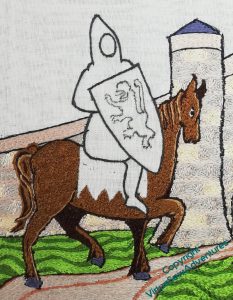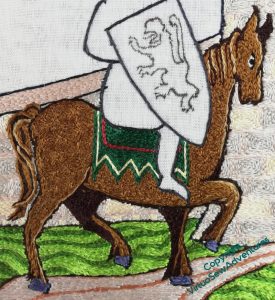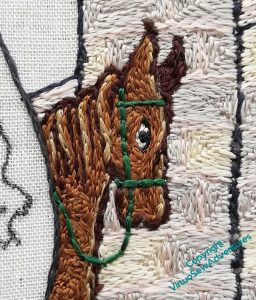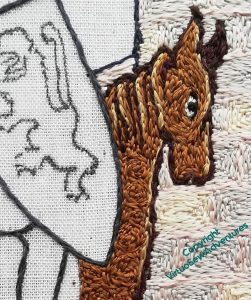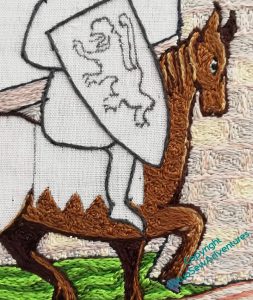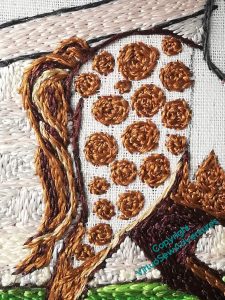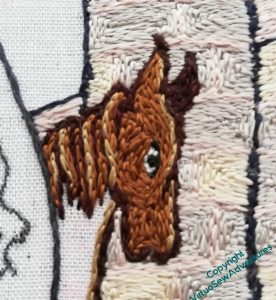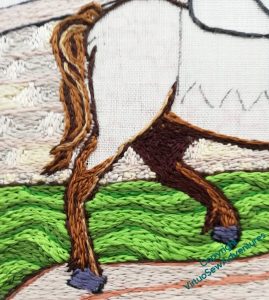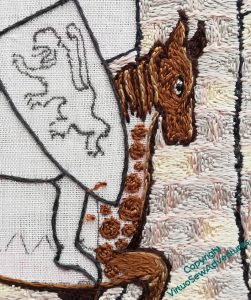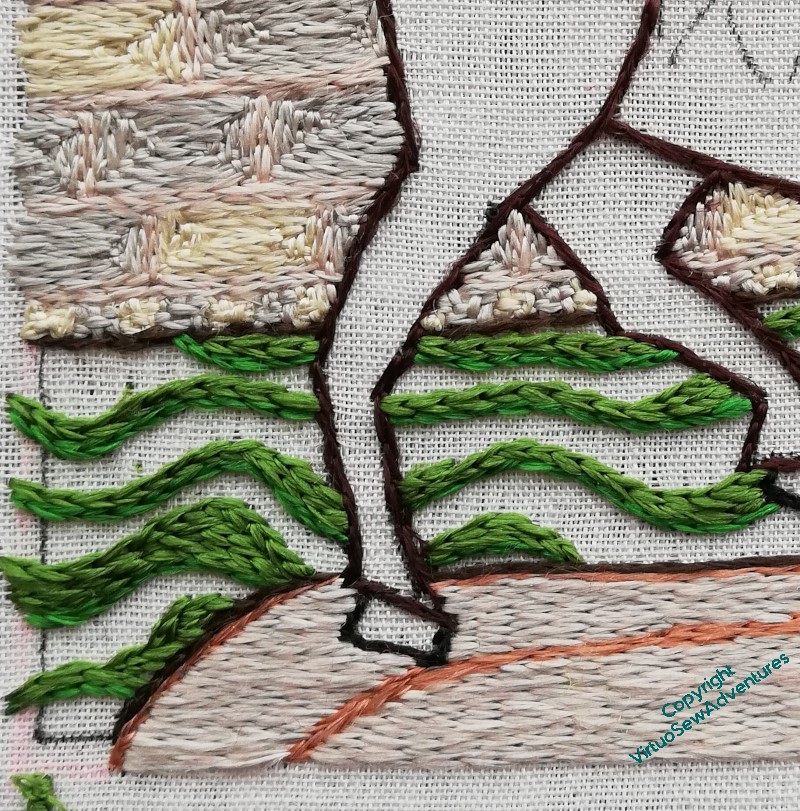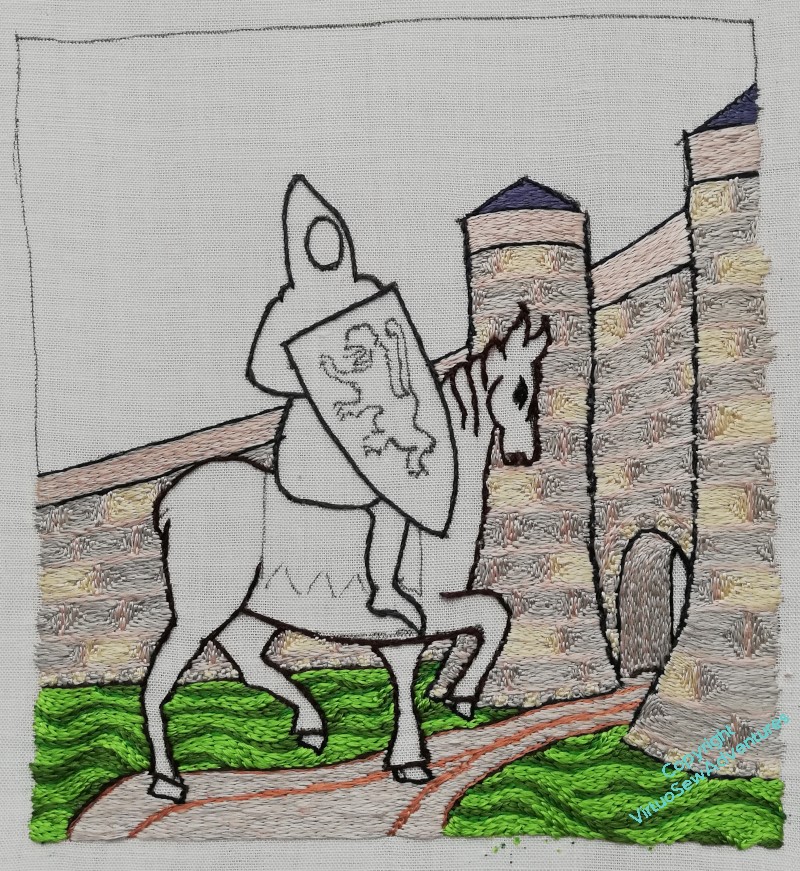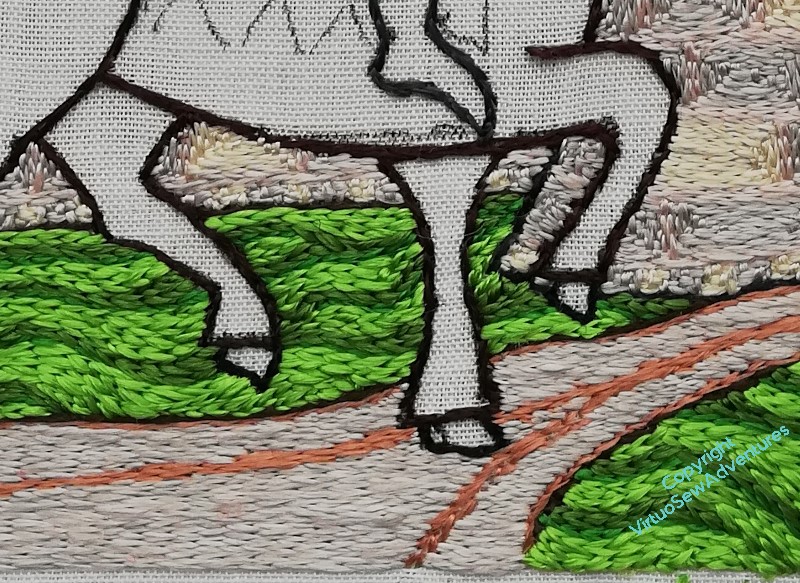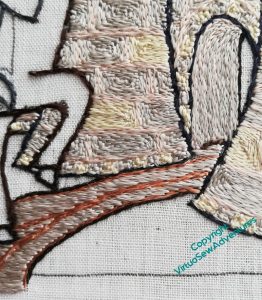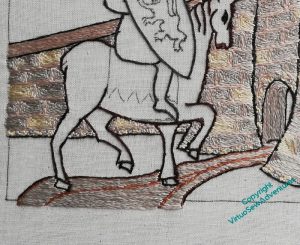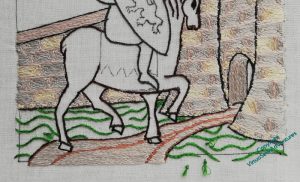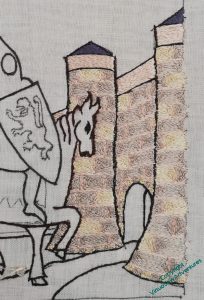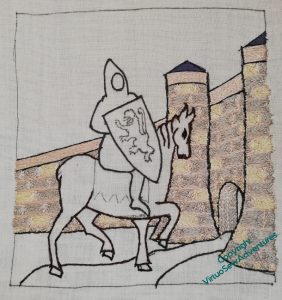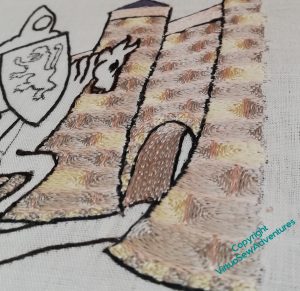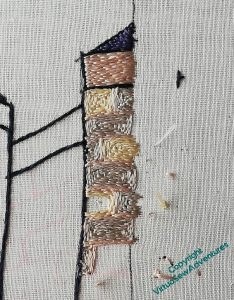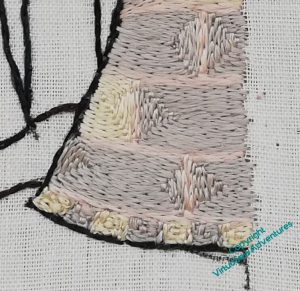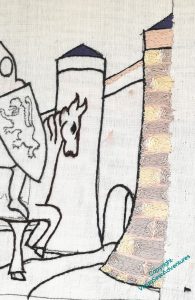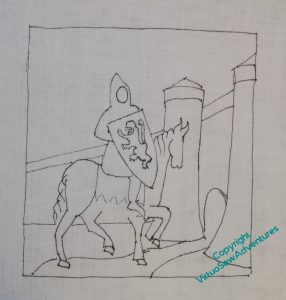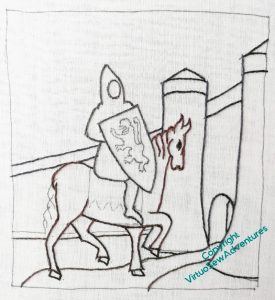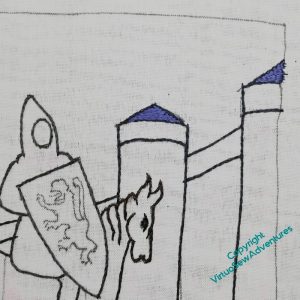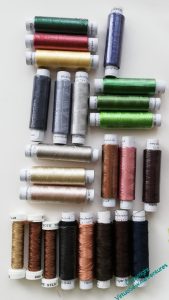Tag: Split Stitch
Adding the saddlecloth and other details
I still have some doubts about the tail I gave Mars, but I also still think that any changes are “tweaks” to be left until I have most of the piece finished and just need to balance it out.
And no, I’ve not forgotten that he needs reins and a few other pieces of tack, but those are details that I didn’t want to have to stitch around. I’m not quite sure how and where they are going to run, although as far as I’m aware William would have steered using reins held in the hands, rather than using the feet, as you see the riders of the the drum horses in mounted bands doing, or as I read the ancient Scythians did (although they were archers!).
I wanted to do the saddle cloth in William’s heraldic colours, and I wanted the extra interest from the points, but I am not entirely sure I’m happy with the colour balance and shapes. I am wondering whether I should make the red line a little wider, or even fill that whole section in red.
Another tweak I am considering is a couple of tiny stitches to highlight the blued steel horseshoes. I have light lines running down the horse’s leg, but not onwards, and while it’s the tiniest of details, I remember realising with some of the Thistle Threads pieces just how much of an impact a tiny detail can have..
I’ve couched several strands of silk together to make a headstall and reins, and again, there may be tiny details to add, when the shield is in place, to help create the right sense of William, as the wealthy and successful tournament winner, high in the favour of Henry The Young King, on a visit to the kinsman under whose auspices he trained, dripping in tournament bling, and generally showing off a bit.
He settled down as he got older, but given that his father was rather unsatisfactory, and even the Lord of Tancaville dropped him at an inconvenient moment in his youth, a bit of rubbing their noses in his success would be only human!
More on the Horse, hereafter known as “Mars”
I do wonder whether the mane is quite luxuriant enough. Like the tail, if I decide it needs more, I can probably add some length; if I’d been thinking straighter, I might have given him a short cropped mohican, because I suppose you don’t want to give an enemy something to hang on to as you charge them down, which a mane might well.
But then, no-one suggests that warhorses had docked tails, so I may be overthinking this!
There are all of about six stitches of white silk around the eye (my flat silk from working the Amarna Family Group) and they seem to be just enough to make it suitably staring. This is clearly a Visit of Ceremony, and Mars is determined not to let the side down, so he is focused and crisp in his movements.
I’m going to give him a saddlecloth in William’s heraldic colours, so I am leaving all that unstititched for now. And I have made very sure that the darks help him to feel solid and stocky.
I did say that I would be going around in circles for quite some time!
The stitching of the “dapples” in the same colour as the background give him a slightly thicker coat than a modern race horse, and I am hoping that the alternation of the textures will help knit the piece together, creating a a sort of counterchange: the shield and saddlecloth smooth, like the top of the wall and the path beneath his hooves, while the walls and horse are slightly rough, bouncing the light in different directions.
Incidentally, while I’m working this section, I’ve been thinking and planning for the “frame”, and the ideas keep changing beneath my feet. So if you were wondering where my plans were – the answer is “in flux”!
William’s Horse
William’s horse is going to need a name, isn’t he! At the moment, suggestions range from “Woros” (think about it for a moment…!) to “Champion The Wonder Horse” (I imagine his groom calls him Bob!) to “Jeff”, via “Mars”, “Thunderer”, and “Dobbin”. I think “Dobbin” is better suited to the horse in the canvaswork!
However, onward!
As it turned out, the colours I chose didn’t quite shade through each other as I would have wished, since two of them were too close together (however good the pictures, online ordering has hazards), so it took me some time to work out what to do.
That “what” turned out to include fishing out a pale cream from among my Thistle Threads reels, which included some filament silk, fortunately. It’s rather finer than the rest of the silk in this piece, so I need six lengths to match four from those.
I do wonder whether the tail is quite luxuriant enough, but if it looks a bit spindly when the whole thing is finished, I can add more – although stitching over the wall is quite effortful!
Please note, also, the wonderful blued-steel hooves. Unless they are slate!
I know that roans are not usually shown as dappled, but I decided that I wanted some texture in the horse. I’m intending to make the shield as smooth as possible, and I think a bit of surface variation in the horse will increase the contrast.
So, I shall be going round and round in circles for quite some time!
The grounds around the castle
In her book, Tanya suggested using a slightly thicker thread for the ground (that is, more strands in the needle), to help it look a bit more uneven without interfereing with the glorious light effects of silk. I decided to vary the different colours as well, to help with that effect. This is the mid tone, although the “dark” isn’t so much dark as a different tint – that’s because I bought it online, and when I started stitching with it, it wasn’t quite the colour I thought it would be.
That said, I think it has turned out very well indeed. I enjoyed trying to keep the curves curving the way they needed to, varying the way each colour filled the allotted space, changing the way the lines flowed. It somehow does manage to look a little like an illustration in a book of fairy tales, partly because of the lines of colour, partly, I think, because the lightest of the greens is very much in that vein.
Not an Arthur Rackham illustration, obviously!
I love the way the grass has made the horse look much crisper, as though he’s conscious that this is An Occasion, and he’s putting his best foot forward.
But I do keep looking at him very panicked, to make sure that he’s not going to fall over. I once did a painting of an elephant, and it was only afterwards that I realised that the poor beast would have overbalanced and landed on his side with a rib-crushing Thump! if what I had painted had been accurate observation…
The road in to the castle
It took a certain amount of puzzling to come up with a choice of colour for the path. I wanted it to help to anchor the scene, but at the same time, I didn’t want it dark enough to challenge the horse, and it seemed logical that it would share some tones with the stonework of the castle. I wanted some wheel ruts as well, although of course they run togther into a single line quite soon.
And then there was stitch direction to think about. A stitcher’s thinking is never done!
Well, a bit of thought, and the stitch direction was obvious – horizontal. The stonework is angular and archway is vertical/follows the curve, so horizontal seemed a good contrast.
Similarly, I settled on using both the pink and the grey from the stonework in the needle. I thought the yellow might brighten the road a bit too much for comfort!
Once the path was done, I could move on to the grass. I thought of doing some rather mad tussocks, going up and over the castle walls, but in the end it seemed to me that the area close to the castle wouldn’t be neglected to that extent. Whichever fairy tale I want my viewers riffing off, I don’t think the briar-overgrown castle of Sleeping Beauty is the one!
William’s Castle
I’m trying to work this systematically (I may also be slightly anxious about tackling William!), so the first thing was to finish the castle.
And there’s a lot of castle…
The yellow blocks appear only on every other row, and I’ve tried to make sure that they never line up. Once I’d worked the gatehouse itself I carried on to work the wall behind it, and then paused for thought.
The interesting question at this point was to decide how to work the wall inside the gatehouse, the “tunnel”, if you like. I wanted some evident difference in relation to the blocks of stone in the walls, and in the end, settled on alternating rows of grey (stone) and pink (mortar), turning them vertically, following the curve of the arch as best as I could. As I went deeper into the tunnel there were more lines of grey between the pink, although to say the difference is subtle is to rather understate the case!
It is a constant delight to look at the way the silk changes in appearance as the stitches change direction, and even more so to change the angle of view, so I suspect you will see a good few shots like this over the course of the piece.
Doesn’t it look lovely – and don’t these quiet, pearly tones help to create the fairytale atmosphere I’m looking for!
William Marshall – first Turret
I had three colours for the stone – a grey, a cream, and a pale rose. The idea is to echo the colour variation you often see in stone when you start looking, but also, at least some medieval masonry made ornamental use of colour variations. Again, remember that I am looking for a faintly mythological feeling to this, not a historically accurate one, so I don’t mind that I’m tweaking my representation of the Chateau de Tancarville until William’s kinsman wouldn’t recognise his own home. He might, after all, rather like what I’ve done!
I put some thought into whether I would use all three colours in the walls, and if so how, but in the end I decided that since the “sky” will be underside couched in gold, it would be better to put the rose or the grey on the topmost course. Grey felt a bit too lowering, like a stormy sky, and William had quite enough squalls to face in his life, so I chose the rose, and used it also for the mortar.
The narrow course at the base seemed to need a different treatment, still in the the same vein. I used six strands instead of the four I’m using elsewhere, and made a little narrow chequerboard, without any suggestion of mortar.
And here it is, the first turret of the gatehouse complete. I was a little anxious lest the sameness of everlasting split stitch prove exasperating or otherwise offputting, but as it turns out, that’s not the case. I’m finding the different effects of stitch length and direction endlessly intriguing, and while I don’t expect to spend the rest of my stitching days entirely on split stitch, I’m certainly expecting to enjoy William.
William Marshall – beginning to stitch
I have a small lightbox now, so I used that to transfer the design. It was a bit of a battle, because the lines showed through so clearly I couldn’t be sure I’d got them all.
And I hadn’t – spot the non-deliberate mistake!
However, one horse’s belly can be added freehand. I haven’t put in the lines for the reins, either, because I’m anticipating putting them over the top of the stitching below, and that layer of stitching would cover the design lines anyway.
When I began the outline, I used the darkest thread I have, “Ebony”, and it looked a bit monolithic. After a couple of comments from Tanya Bentham, I unpicked it all, took the opportunity to restretch the fabric, which had sagged, and reinstated the outlines with some variation – navy blue for the building, brown for the horse, and dark grey for the armour. They are all very dark colours, so there’s only a slight difference, but there is a difference, and already the design looks livelier.
So, once I had the outlining in, I started with the conical slate roofs on the gatehouse turrets.
At this point, I should admit that those conical roofs are not remotely historical. The seventeenth century engraving that gave me the view of the gatehouse I liked the most didn’t have conical roofs, and I think I can be pretty certain that in William’s time those turrets probably had a man-at-arms on patrol, and no roof.
All that said, I’m not doing an entirely historical piece. I’m telling different stories here, and I want a slightly fairytale/mythological quality to the image. I think the conical roofs help with that.
Ready to Start on William Marshall…
Having spent some time in my stash, deciding that mixing even filament silks might be a bit unpredictable, I finally pulled myself together and placed an order with Devere Yarns. While I waited for them to arrive (it didn’t take long), I went back to Tanya’s book and read the early technique sections again. Homework is always more fun when you’re interested.
I do have some darks left over from the Amarna Family Group, so the outlining is sorted. I’ve got three stone colours, three shades for William’s armour, three greens for grass, three shades for the horse, the three heraldic colours for the shield, and a blue for the slate roofs on the turrets.
The blue is probably also going to be the colour I use for the border.
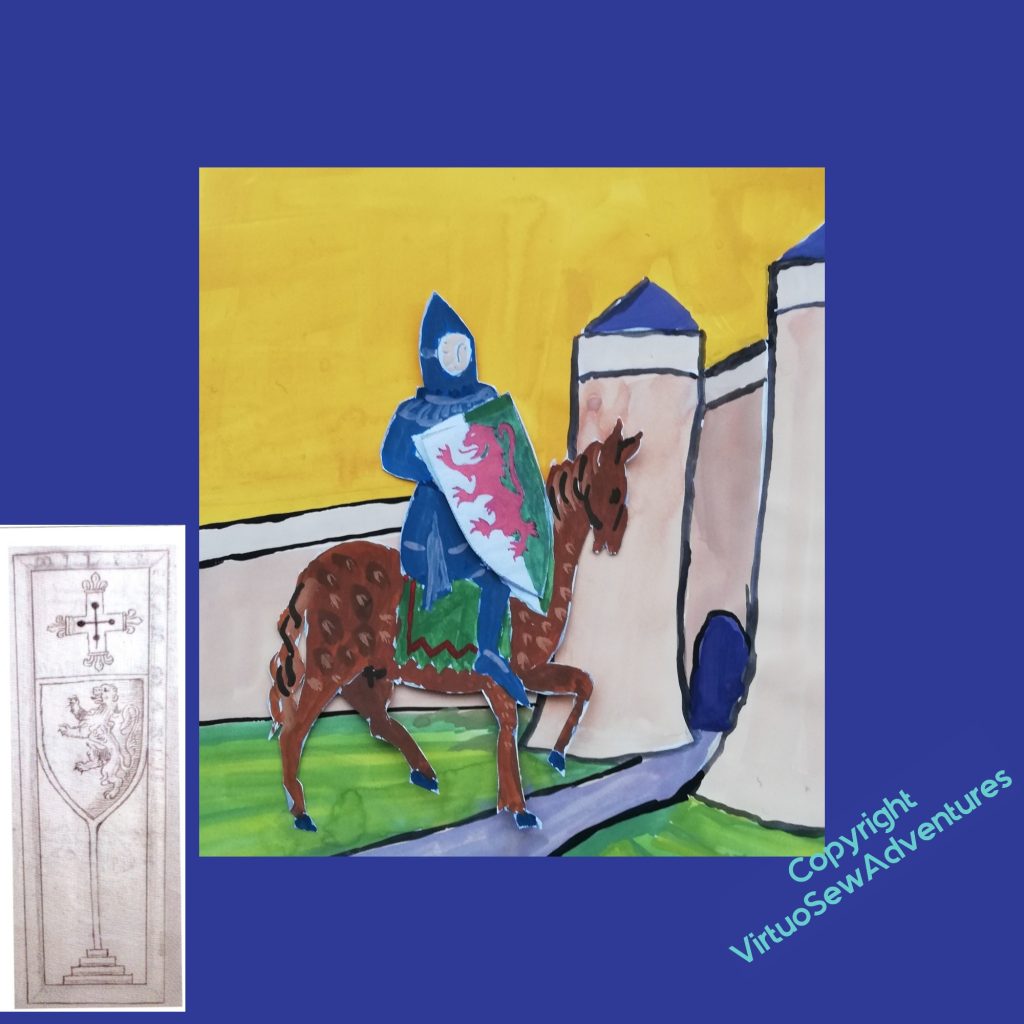
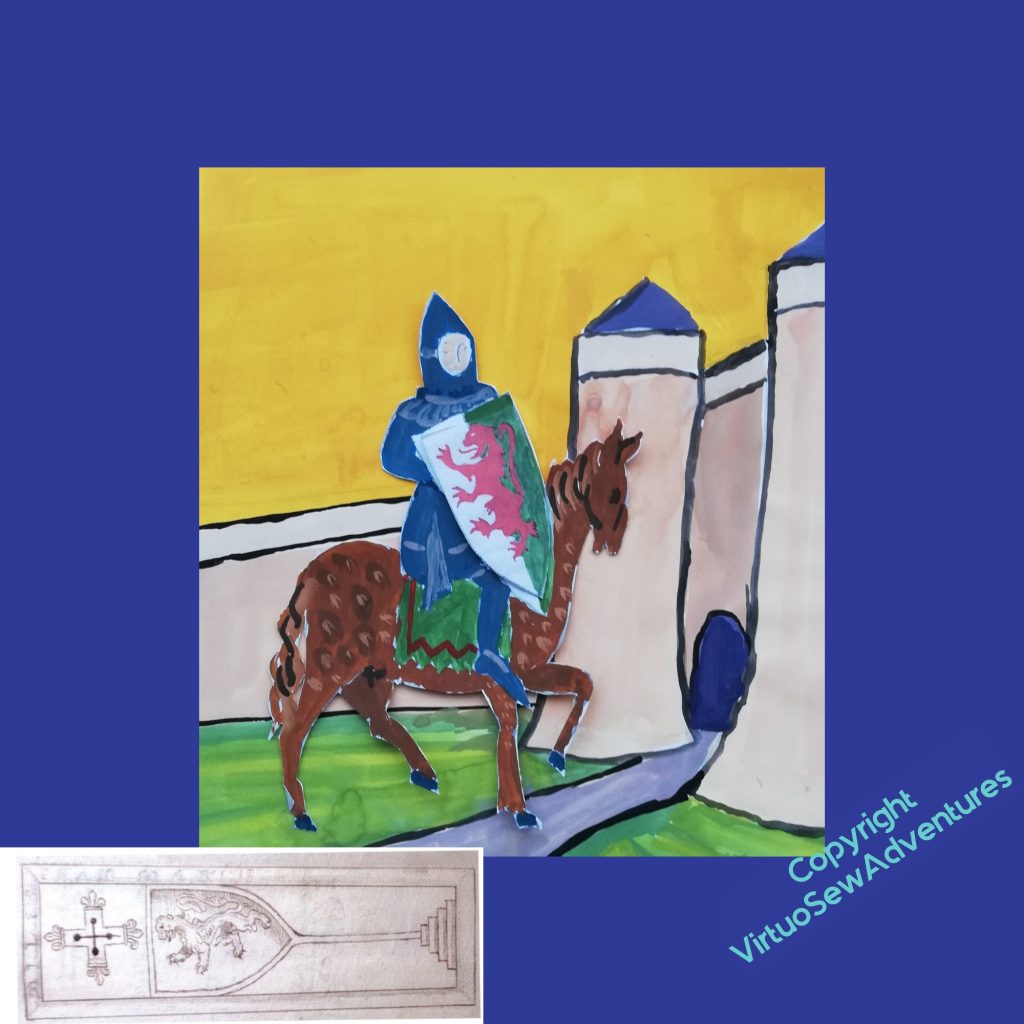
The Victorians remodelled Temple Church, where William is buried, found a strapping six-footer that they believed – based on what we’ve been told of him – to be William, and in due course, reburied him, and everyone else they’d moved, in the garden. So I’m planning a silk border, of blue laid-&-couched work, embellished with roses (for the garden) and common broom (for the Plantagenet kings he served so faithfully).
The grave slab is shown in a leaflet I got when we visited, which is no longer in existence, but is shown in an engraving from the 17th Century, and was thought to be associated with William. The lion looks right, anyway! I’m wondering whether to include that in my design for the border in some way, and if so, in what orientation..

